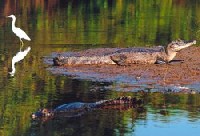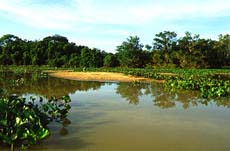|
Ads by Google
The Pantanal Mato-Grossense
The Pantanal mato-grossense is an area of approximately 400,000 km2, most of which in the states of Mato Grosso and Mato Grosso do Sul. The Pantanal occupies also part of Paraguay (where it is called chaco) and Bolivia. Average annual temperature is 24 C, and precipitation is between 1000 and 1500 mm.
Pantanal, in Portuguese, means "swamp"; the name, however, is incorrect, as the Pantanal is not a swamp.
 Pantanal is a vast sedimentary lowland area, with altitudes lower than 200m, surrounded by the Planalts Central and Meridional. The river Paraguai and many of its tributaries, like São Lourenço, Cuiabá, Taquari, Negro, Miranda and Aquidabã, form a network of rivers which cover almost the entire region; several lagoons ocupy spaces between rivers. During the rainy season, from November through April, the rivers overflow and the region, gradually, goes under water. During the dry season, the rivers go back to their courses, and the lands are used for extensive cattle farming (the main economic activity of the region).
Pantanal is a vast sedimentary lowland area, with altitudes lower than 200m, surrounded by the Planalts Central and Meridional. The river Paraguai and many of its tributaries, like São Lourenço, Cuiabá, Taquari, Negro, Miranda and Aquidabã, form a network of rivers which cover almost the entire region; several lagoons ocupy spaces between rivers. During the rainy season, from November through April, the rivers overflow and the region, gradually, goes under water. During the dry season, the rivers go back to their courses, and the lands are used for extensive cattle farming (the main economic activity of the region).
The Pantanal is becoming one of the major ecological destinations in Brazil.
Its localization (right in the middle of completely different ecosystems, like the Amazon, the cerrado and the Atlantic forest), combined with high temperatures and cycles of dry and wet seasons (which favor reproduction and migration of species) gives to the Pantanal the highest density of fauna in the Americas, compared to the richest areas of Africa.
 The fauna is still to be fully catalogued. It is estimated that more than 700 species of bird have habitat in the Pantanal, making it the largest variety in the world; the tuiuiu or jaburu, which looks like a flamingo and is often seen on top of trees during the wet season, became symbol of the region.
The fauna is still to be fully catalogued. It is estimated that more than 700 species of bird have habitat in the Pantanal, making it the largest variety in the world; the tuiuiu or jaburu, which looks like a flamingo and is often seen on top of trees during the wet season, became symbol of the region.
Also, the Pantanal has 230 species of fish (professional fishermen from all over Brazil come to fish here), over 1,000 of butterflies, 89 of mamals and 50 of reptiles (jacares, the Brazilian caymans, are an attraction), living among 1,700 different kinds of plants.
Several species are in danger, like ararinha-azul (blue macaws), ariranha, tamanduá (aarkvard), onça pintada, pantera negra (black panter),cervo pantaneiro (deer from pantanal) and several species of monkeys; threaten comes from predatory action of fur hunters and bird smugglers.
Eco-tourism is better during the dry season, when animals gather around water ponds, facilitating observation. Notice that vaccination against yellow fever is required.
Read also:
The Amazon
Other sites:
 http://www.corumba.com.br
Commercial guide to Corumba, a city which is in the heart of Pantanal. Check out the excellent
photos section http://www.corumba.com.br
Commercial guide to Corumba, a city which is in the heart of Pantanal. Check out the excellent
photos section
 Pantanal News
In Portuguese only. News about Pantanal and region. Pantanal News
In Portuguese only. News about Pantanal and region.
 Pictures by a traveller
Access to the Pantanal is relatively easy (compared to other wild areas, like Amazon), which explains the abundance of photos in the internet Pictures by a traveller
Access to the Pantanal is relatively easy (compared to other wild areas, like Amazon), which explains the abundance of photos in the internet
 Sucuri photos
Sucuri is the biggest specie of snake in Brazil. Warning: some images are quite impressive (sucuri and preys). Sucuri photos
Sucuri is the biggest specie of snake in Brazil. Warning: some images are quite impressive (sucuri and preys).
Back to Top
|
 Pantanal is a vast sedimentary lowland area, with altitudes lower than 200m, surrounded by the Planalts Central and Meridional. The river Paraguai and many of its tributaries, like São Lourenço, Cuiabá, Taquari, Negro, Miranda and Aquidabã, form a network of rivers which cover almost the entire region; several lagoons ocupy spaces between rivers. During the rainy season, from November through April, the rivers overflow and the region, gradually, goes under water. During the dry season, the rivers go back to their courses, and the lands are used for extensive cattle farming (the main economic activity of the region).
Pantanal is a vast sedimentary lowland area, with altitudes lower than 200m, surrounded by the Planalts Central and Meridional. The river Paraguai and many of its tributaries, like São Lourenço, Cuiabá, Taquari, Negro, Miranda and Aquidabã, form a network of rivers which cover almost the entire region; several lagoons ocupy spaces between rivers. During the rainy season, from November through April, the rivers overflow and the region, gradually, goes under water. During the dry season, the rivers go back to their courses, and the lands are used for extensive cattle farming (the main economic activity of the region). The fauna is still to be fully catalogued. It is estimated that more than 700 species of bird have habitat in the Pantanal, making it the largest variety in the world; the tuiuiu or jaburu, which looks like a flamingo and is often seen on top of trees during the wet season, became symbol of the region.
The fauna is still to be fully catalogued. It is estimated that more than 700 species of bird have habitat in the Pantanal, making it the largest variety in the world; the tuiuiu or jaburu, which looks like a flamingo and is often seen on top of trees during the wet season, became symbol of the region.